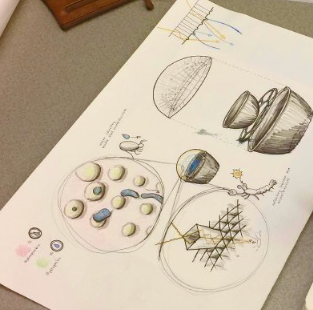
“I want to build a community center where people come together and get along, and I’m looking at nature for ideas because of all of the harmonious and interconnected relationships where animals and plants co-exist.”
I was talking with an architecture graduate student in a class on bio-inspired design. She was one of many students who was excited to dive into the approach of biomimetics, looking to nature for inspiration in solving human problems, whether it was building a building or making a new robot or drug. This student’s genuine reverence for nature was inspiring, but also captured some of the primary challenges in biomimetic approaches. Most of the disciplines taking such approaches were outside of biology, and diving into biology without a biologist at hand, resulting in misunderstandings of biology that could limit their application.
This class was one in a series that attempted to get around these issues by bringing biologists together with designers and engineers, and build teams of students to tackle projects through interdisciplinary collaboration. In this particular instance, we started by taking a step back to discuss how conflict is quite common in nature, but then zeroed in on cases where an understanding of altruism and cooperation in the natural world might inform architecture. Might a decorative mural of human eyes increase cooperative behavior? Experimental evidence suggests yes, but we agreed with the designers that it would be creepy. It might be a better bet to add features that reduce anonymity and increase the chances people will meet again, conditions that support the evolution of altruistic behavior.
This interaction was the tip of a bigger iceberg that catalyzed the beginning of our currently funded Templeton project on “function and biomimetics.” In this work, we are building the idea of “function” as a bridge between biology and bio-inspired design. For instance, an engineer interested in addressing air filtration through a biomimetic approach might turn to the database “Ask Nature” to search for examples of how nature filters things, and explore biological analogies from marine tunicates to flamingoes. But engineers and biologists come at the idea of function from very different perspectives. A biologist might approach a biological trait thinking about the broader evolutionary forces that brought it into existence, a viewpoint that may make them aware of limitations of biomimetics, and also point towards additional biological ideas.
In our current work, we are building a set of tools for engineers and designers to navigate biological space. What key knowledge will help biodesigners use biology in their own applications, without having to become biologists themselves? And what principles of biology offer general lessons useful in design space? Our team consists of evolutionary biologists, philosophers, architects, landscape designers, and engineers. We will test this content in the classroom and our own bio-inspired design practice. Through study and reflection, we will also explore how this collaboration changes the perspective and practices of the designers and engineers involved. Overall, we expect these efforts will also inform the broader understanding of function, purpose, and intention in biology as well as bio-inspired design.
